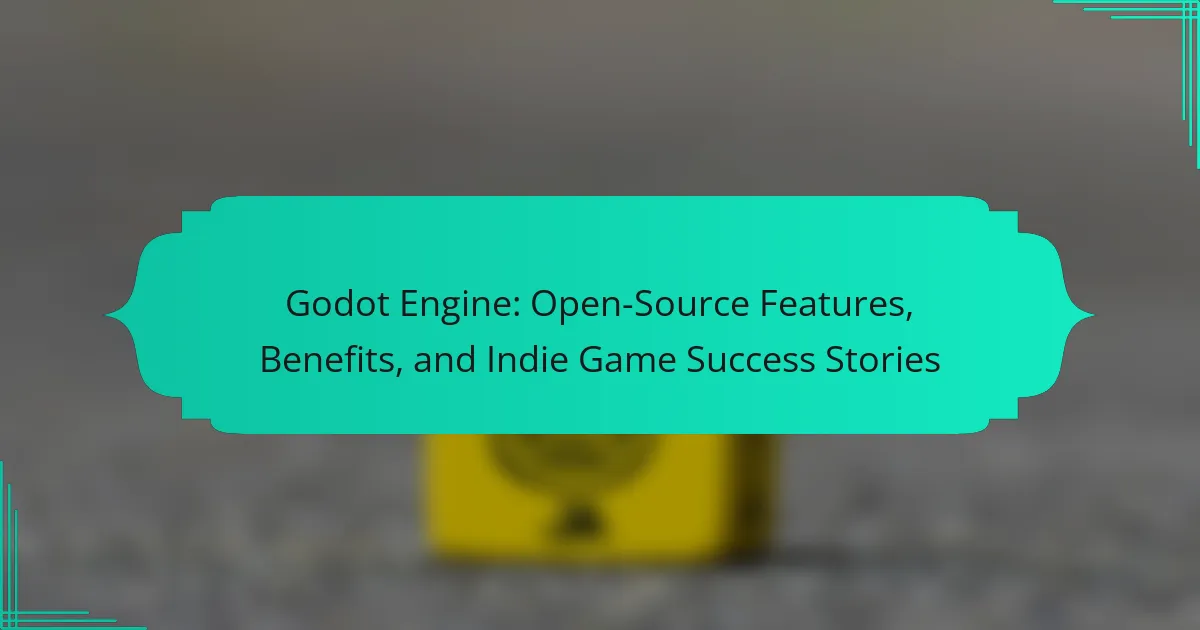Godot Engine empowers indie game developers with its open-source features and benefits. The platform supports 2D and 3D game development, offers a user-friendly interface, and promotes community engagement. Notable success stories like “Celeste” and “A Short Hike” highlight its effectiveness. This article explores Godot’s key features, advantages for developers, and the challenges faced in the game development landscape.

What are the core features of Godot Engine?
Godot Engine offers powerful open-source features that cater to indie game developers. Key features include a user-friendly scene system, a versatile scripting language (GDScript), and cross-platform deployment capabilities.
The engine supports both 2D and 3D game development, enabling a wide range of creative possibilities. Additionally, its active community contributes to a wealth of tutorials and resources, enhancing the development experience.
Notably, Godot’s unique attribute is its fully integrated development environment, which streamlines workflows. The engine’s licensing model allows developers to retain full ownership of their projects, promoting indie game success.
As a result, many indie games have thrived using Godot, showcasing its effectiveness and versatility in the gaming industry.
How does Godot’s open-source nature enhance flexibility?
Godot’s open-source nature significantly enhances flexibility by allowing developers to modify the engine according to their specific needs. This adaptability supports diverse game design choices and fosters community collaboration. Developers can access the source code, enabling them to implement custom features or optimize performance. As a result, Godot accommodates a wide range of project types, from simple 2D games to complex 3D experiences, making it an ideal choice for indie developers seeking creative freedom.
Which programming languages are supported by Godot?
Godot Engine supports multiple programming languages including GDScript, C#, VisualScript, and C++. GDScript is the primary language designed specifically for Godot, offering ease of use and integration. C# provides a familiar syntax for developers coming from Unity, while VisualScript allows for node-based programming. C++ can be used for performance-critical components.
What types of games can be created with Godot Engine?
Godot Engine supports various game types, including 2D platformers, 3D action games, puzzle games, and simulations. Its versatility allows developers to create both simple and complex projects. For example, indie developers often leverage Godot for unique storytelling experiences and innovative gameplay mechanics. The open-source nature of Godot fosters a collaborative environment, enhancing the development of diverse game genres.
How does the scene system work in Godot?
The scene system in Godot allows developers to create and manage game elements efficiently. It uses a node-based architecture where each scene is a collection of nodes, enabling modular design. Scenes can be instantiated as reusable components, promoting flexibility and organization. This structure supports hierarchical relationships, allowing nodes to inherit properties from parent nodes, streamlining development processes.
What are the key differences between Godot 3 and Godot 4?
Godot 4 introduces significant improvements over Godot 3, including enhanced graphics capabilities, a new rendering engine, and improved performance. Godot 4 features Vulkan support, offering better visuals and efficiency. Additionally, the scene system has been redesigned for better organization, and the scripting language has been updated for more flexibility. Overall, these advancements make Godot 4 a more powerful tool for indie game developers.

What benefits does Godot Engine offer to indie developers?
Godot Engine offers indie developers numerous benefits, including flexibility, a strong community, and cost-effectiveness. Its open-source nature allows for extensive customization and control over game development. The lightweight design facilitates rapid prototyping and iteration, essential for indie projects. Additionally, Godot’s user-friendly interface and comprehensive documentation support developers of all skill levels, enhancing productivity and creativity.
How does Godot’s licensing affect game development?
Godot’s open-source licensing positively impacts game development by eliminating costs and providing flexibility. Developers can modify the engine to suit their needs, fostering innovation. This accessibility has led to numerous indie game success stories, demonstrating the engine’s effectiveness in a competitive market. The community-driven nature of Godot encourages collaboration and resource sharing, further enhancing its appeal to indie developers.
What cost savings can developers expect using Godot?
Developers can expect significant cost savings using Godot Engine due to its open-source nature and zero licensing fees. This allows for reduced initial investment compared to proprietary engines. Additionally, Godot’s user-friendly interface and extensive documentation streamline development time, further lowering costs. The engine’s versatility supports multiple platforms, enabling developers to reach broader audiences without incurring additional expenses. These factors contribute to a favorable financial outcome for indie developers and small studios.
How does Godot support cross-platform development?
Godot supports cross-platform development by allowing developers to create games for multiple platforms from a single codebase. It offers built-in tools for exporting projects to Windows, macOS, Linux, iOS, Android, and HTML5. This flexibility enhances accessibility and reach for indie developers. Additionally, Godot’s open-source nature enables community contributions, ensuring continuous improvement and support for new platforms. Cross-platform compatibility is further strengthened by Godot’s lightweight architecture, which optimizes performance across devices.
Which community resources are available for Godot users?
Godot users have access to various community resources, including forums, documentation, and tutorials. These resources facilitate learning and collaboration among developers. Notable platforms include the official Godot documentation, Q&A forums, and community-driven Discord servers. Additionally, users can find numerous video tutorials and open-source projects for reference. These resources enhance the overall development experience and support indie game success stories.

What are some notable indie games developed with Godot?
Notable indie games developed with Godot include “A Short Hike,” “Celeste,” and “Rogue Heroes: Ruins of Tasos.” These games showcase Godot’s versatility and user-friendly features. “A Short Hike” offers exploration in a charming environment, while “Celeste” impresses with its challenging platforming mechanics. “Rogue Heroes” combines action and adventure elements, highlighting Godot’s capability for diverse game genres. Each title reflects the benefits of using an open-source engine, such as community support and flexibility in development.
Which success stories highlight Godot’s capabilities?
Godot engine has numerous success stories showcasing its capabilities. Notable examples include “A Short Hike,” which gained critical acclaim for its charming graphics and gameplay, and “Deponia,” a popular adventure game series that highlights Godot’s versatility. “Sonic Fan Games” also demonstrates how Godot supports community-driven projects. Additionally, “Rogue Heroes: Ruins of Tasos” achieved commercial success, illustrating Godot’s potential for indie developers. Each of these stories emphasizes Godot’s open-source nature, ease of use, and robust community support.
How have developers leveraged Godot for unique gameplay experiences?
Developers leverage Godot for unique gameplay experiences through its flexible open-source features. The engine allows for rapid prototyping and customization, enabling indie developers to experiment with innovative mechanics. Notable examples include games like “Hollow Knight” and “A Short Hike,” which showcase diverse gameplay styles. Godot’s scripting language, GDScript, simplifies coding, fostering creativity. Additionally, its strong community support provides resources for troubleshooting and collaboration, enhancing the development process.
What lessons can be learned from successful Godot projects?
Successful Godot projects demonstrate key lessons in game development. First, leveraging the engine’s open-source nature fosters community collaboration, enhancing innovation. Second, prioritizing performance and optimization leads to smoother gameplay experiences. Third, focusing on storytelling and player engagement creates memorable experiences. Lastly, regular updates and community feedback are vital for ongoing success.

What challenges do developers face when using Godot Engine?
Developers face several challenges when using Godot Engine, including limited documentation, performance optimization issues, and a smaller community compared to other engines. The lack of extensive resources can hinder learning and troubleshooting. Additionally, while Godot supports multiple platforms, developers may encounter difficulties in achieving consistent performance across them. Finally, some advanced features found in other engines may be less mature or absent in Godot, impacting project complexity and scope.
What are common limitations of Godot compared to other engines?
Godot Engine has some limitations compared to other game engines. Its community support is smaller, leading to fewer resources and tutorials. The asset library is less extensive, which may restrict available tools and assets. Performance can lag behind engines like Unity or Unreal, especially in larger projects. Lastly, advanced graphical features may not be as robust, impacting high-end visual fidelity.
How do developers overcome performance issues in Godot?
Developers overcome performance issues in Godot by optimizing code, using efficient asset management, and leveraging built-in profiling tools. They often refactor scripts to reduce complexity and improve execution speed. Additionally, developers may utilize the Godot community resources for best practices and performance tips.
Efficient resource loading and scene management also play a significant role in enhancing performance. By implementing techniques such as object pooling and level streaming, developers can minimize memory usage and loading times.
What support is available for troubleshooting in Godot?
Godot provides extensive support for troubleshooting through its documentation, community forums, and GitHub repository. The official documentation includes guides and FAQs that address common issues. Community forums allow users to seek help from experienced developers. Additionally, the GitHub repository features an issue tracker for reporting bugs and requesting assistance. These resources collectively enhance problem-solving for users of the Godot Engine.

What are the future trends for Godot Engine in game development?
Godot Engine is poised for significant growth in game development, emphasizing accessibility and community-driven innovation. Future trends include enhanced support for 3D game development, improved performance optimizations, and the integration of advanced features like visual scripting.
The expanding community will likely lead to a wealth of user-generated assets and plugins, enriching the development ecosystem. Additionally, as more indie developers adopt Godot, success stories will inspire further adoption, reinforcing its position as a leading open-source game engine.
As a result, Godot’s trajectory suggests a future where it competes more robustly with proprietary engines, driven by its unique attributes of flexibility and cost-effectiveness.
How is the Godot community evolving in 2025?
The Godot community is rapidly evolving in 2025, focusing on enhanced collaboration and resource sharing. Increased contributions from developers are enriching the engine’s open-source features. New educational resources and tutorials are emerging, fostering a supportive environment for indie game developers. The community’s growth is reflected in more successful game releases, showcasing the engine’s capabilities. As a result, Godot is becoming a preferred choice for indie developers seeking innovative tools.
What upcoming features are anticipated in future Godot releases?
Upcoming Godot releases are expected to include enhanced rendering capabilities, improved performance, and expanded support for 3D features. Anticipated updates focus on better integration with modern graphics APIs, such as Vulkan, and advancements in animation tools. User interface improvements and additional scripting features are also on the horizon, aimed at streamlining game development for indie creators. These enhancements will further solidify Godot’s position as a leading open-source game engine.
How can developers prepare for the future of Godot Engine?
Developers can prepare for the future of Godot Engine by embracing its open-source nature and staying updated on new features. Engaging with the community fosters collaboration and knowledge sharing. Learning GDScript and exploring Godot’s extensive documentation enhances skill sets. Participating in game jams showcases talent and builds portfolios. Lastly, understanding emerging trends in game development can inform project direction and innovation.
What are best practices for optimizing projects in Godot?
To optimize projects in Godot, focus on efficient resource management, code organization, and performance profiling. Use the following best practices:
1. Leverage Godot’s scene system for modularity.
2. Utilize built-in tools for performance monitoring.
3. Optimize asset sizes and formats.
4. Implement asynchronous loading for large resources.
5. Use GDScript’s built-in functions for efficiency.
6. Regularly profile and test on target platforms.
These practices enhance project performance and streamline development in Godot.
